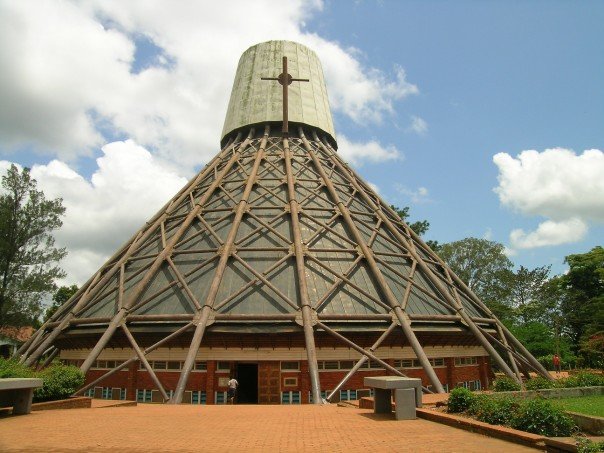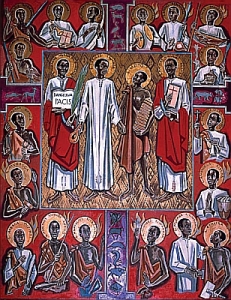
(Photo credit: Episcopal Church of the Holy Spirit, Waco, TX)
By Faith J. H. McDonnell (@Cuchulain09)
One hundred and twenty-seven years ago this week, with leg irons and with yokes around their necks stringing them together, (eerily foreshadowing the way in which children abducted by Joseph Kony and his Lord’s Resistance Army would walk in their captivity) 32 young Ugandan captives were forced to walk 37 miles to a place called Namugongo. These boys were on a death march ordered by Mwanga, the kabaka, or king, of Buganda, the largest of Uganda’s traditional kingdoms.
The captives who survived the tortuous trek spent seven more days in chains as an enormous pyre was prepared. On June 3, 1886, they were wrapped and bound in reed mats and laid side by side on the pyre. These boys had been court pages to Mwanga. They were being burned alive for daring to refuse the king’s sexual advances.
Many of these young martyrs had become Christians through the missionary work of the “White Fathers,” the Roman Catholic Society of Missionaries of Africa, founded by Charles Cardinal Lavigerie, an ardent foe of slavery and the Archbishop of Algiers. Enough converts were baptized and shared the faith with others that Christianity soon threatened the influence and power of the witch doctors and the Arab Muslims who operated the slave trade in Uganda and promoted Islam to the king. The fascinating history of this period of Uganda comes from the book, Planting the Faith in Darkest Africa: The Life Story of Father Simeon Lourdel, by F. A. Forbes. The whole book is available online, on the website of the Friends of the Society of Missionaries of Africa, also called “The Pelicans.”
Mwanga was only eighteen when he inherited the throne of his father King Mutesa in 1884. He elevated several Christians to high positions in his kingdom, but soon discovered that they put loyalty of Christ above traditional loyalty to the king and his sexual proclivities. The Arabs and witch doctors attempted and succeeded in inciting Mwanga to anger against the Christian pages.
The first Roman Catholic convert to be executed was Joseph Mkasa Balikuddembe, the chief steward and leaders of the pages. After he was beheaded and burned on November 15, 1885, Mwanga boasted, “After I’ve killed that one, all the others will be afraid and will abandon the religion of the priests.” Exactly the opposite happened: On the night of Mkasa’s martyrdom, 12 catechumens were baptized, and 105 more were baptized the following week. So it happened that six months later, Mwanga discovered that his court was full of Christians and decided to execute them all.

Even in their death, however, these brave young Ugandans thwarted the evil the king intended. They welcomed the privilege of dying as martyrs for Christ. Their attitude bewildered the soldiers who were ordered to execute them. One of the executioners later reflected that the prisoners acted as if they were going to a wedding and that the executioners were serving at the banquet.
The martyrdom of these 32 and others that came before them and followed after them did not frighten away new converts or stamp out the flames of faith. Instead, their witness inspired and empowered the Church in Uganda. Today more than eight million Ugandans are Roman Catholic and more than seven million are Anglican. Every year on June 3, the faith of the Uganda martyrs is celebrated at the site of their death, where both Catholic and Anglican churches have constructed memorial shrines.
Less than half a century after the fire of martyrdom had scarred Uganda, a new fire blazed across the land — the East African revival began in Uganda, when Joe Church, an English missionary doctor working in Rwanda, met with Simeoni Nsibambi, a Ugandan Anglican, on Namirembe Hill in 1929, less than 20 miles from Namugongo, where Uganda’s first martyrs met their Lord. The Namirembe encounter resulted in the transformation of thousands of lives and started in East Africa a revival conflagration that has never gone out.
O God, by whose providence the blood of the martyrs is the seed of the Church: Grant that we who remember before thee the blessed martyrs of Uganda, may, like them, be steadfast in our faith in Jesus Christ, to whom they gave obedience even unto death, and by their sacrifice brought forth a plentiful harvest; through Jesus Christ our Lord, who liveth and reigneth with thee and the Holy Spirit, one God, for ever and ever.
(A Prayer for the Feast Day of the Martyrs of Uganda)
(Text adapted from Girl Soldier: A Story of Hope for Northern Uganda’s Children, Chapter 4, “Fire of Martyrdom,” by Faith J. H. McDonnell and Grace Akallo, Chosen Books, 2007.)




Comment by clknight225 on June 4, 2013 at 5:11 pm
Awesome structure!
Comment by David Virtue on June 5, 2013 at 7:22 am
thanks will post to VOL..
D
On Tue, Jun 4, 2013 at 2:31 PM, Juicy Ecumenism – The Institute on Religi
Comment by Faith McDonnell on June 5, 2013 at 10:40 am
Thank you, David!
Comment by Tracy McCollister on June 8, 2013 at 1:45 am
Really an interesting story which should be widely disseminated, especially among U.S. Christians.
Tracy McCollister
Warner Robins, Ga.